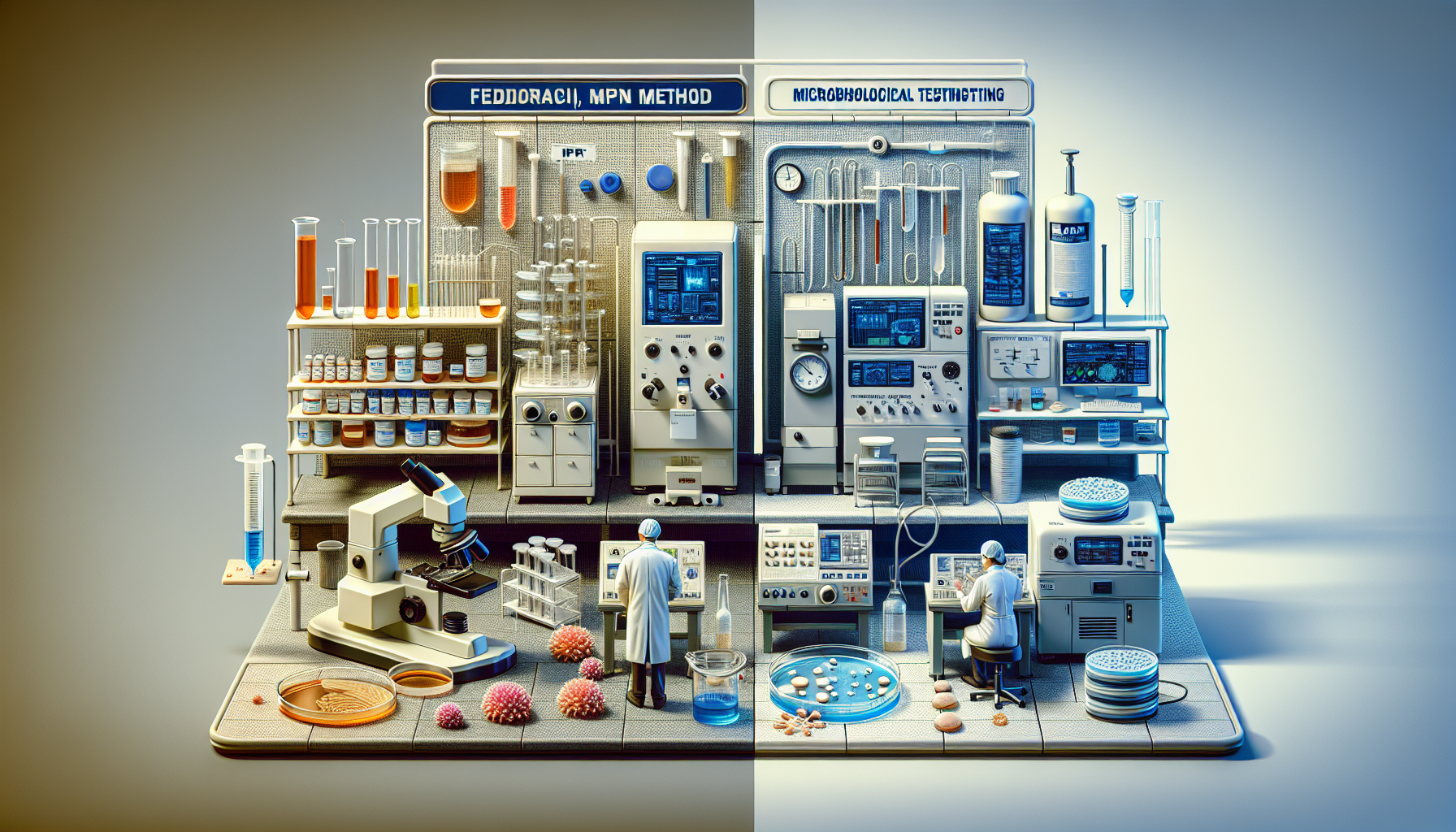
Microbiological testing is a critical quality control and assurance component in various industries, including food, pharmaceuticals, and water treatment. These tests are designed to detect and quantify the presence of microorganisms, ensuring the safety and quality of products. This article will explore two widely used microbiological testing methods: the FDA Most Probable Number (MPN) method and the Rapid Colony Forming Unit (CFU) method. By understanding each approach's principles, advantages, and limitations, readers will be better equipped to make informed decisions about their microbiological testing needs.
The FDA MPN method is a statistical technique used to estimate the quantity of viable microorganisms in a sample. This method includes inoculating several replicate samples with different dilutions of the test material and then observing whether or not growth occurs in each replicate. The MPN value is then calculated based on the pattern of positive and negative results, providing an estimate of the microbial population in the original sample. On the other hand, the Rapid CFU method is an alternative approach that focuses on the direct enumeration of colony-forming units (CFUs) on agar plates. This method utilizes specialized media to rapidly detect and count microbial colonies, providing a more direct and quantitative assessment of the microbial population.
Key Takeaways
- The FDA MPN and Rapid CFU methods are two standard microbiological testing methods used in the food industry.
- The MPN method relies on statistical analysis to estimate the concentration of microorganisms in a sample, while the Rapid CFU method directly counts the number of colony-forming units.
- The MPN method offers advantages, such as being suitable for low microbial concentrations, while the Rapid CFU method provides faster results.
- Factors such as accuracy, time to results, and cost should be considered when comparing the two methods.
- Choosing the appropriate microbiological testing method should consider the industry's specific needs, regulatory requirements, and emerging trends in testing technologies.
Understanding the FDA MPN Method
Principle of the MPN Method
The FDA MPN method is a statistical approach to estimating the number of viable microorganisms in a sample. It involves inoculating multiple replicate samples with dilutions of the test material, followed by observing growth or no growth in each replicate. The MPN value is then calculated based on the pattern of positive and negative results, providing an estimate of the microbial population in the original sample. This method relies on the principle that the distribution of microorganisms in a sample follows a Poisson distribution, which allows for the estimation of the most probable number of microorganisms present.
The MPN method is beneficial for samples with low microbial counts, as it can provide a more accurate estimation compared to direct plating techniques. However, the method's statistical nature can introduce some uncertainty in the final results, and its accuracy may be affected by factors such as sample preparation and incubation conditions.
Advantages of the MPN Method
The MPN method is widely accepted and recognized by regulatory bodies, making it a reliable and standardized approach to microbiological testing. This method is beneficial for samples with low microbial counts, as it can provide a more accurate estimation compared to direct plating techniques. The MPN method is a well-established and widely used approach, contributing to its acceptance and recognition within the industry.
The statistical nature of the MPN method allows for the estimation of microbial populations even in samples with low counts, which can be challenging for other enumeration techniques. This makes the MPN method a valuable tool for testing samples with low numbers of target microorganisms, such as food, pharmaceutical, or water samples.
Limitations of the MPN Method
One of the MPN method's main limitations is its time-consuming testing process. The method typically requires multiple days to complete, as it involves inoculating multiple replicate samples, followed by observing growth or no growth in each replicate. This extended timeline can be a drawback when rapid results are required, such as in process control or product release scenarios.
Additionally, the MPN method's statistical nature can introduce some uncertainty in the final results. Factors such as sample preparation, media selection, and incubation conditions may affect the method's accuracy, which can influence the pattern of positive and negative results. This inherent variability in the MPN method should be considered when interpreting the results and making decisions based on the estimated microbial population.
Exploring the Rapid CFU Method
Principle of the Rapid CFU Method
The Rapid CFU method is an alternative approach to microbiological testing focusing on the direct enumeration of colony-forming units (CFUs) on agar plates. This method utilizes specialized media to rapidly detect and count microbial colonies, providing a more direct and quantitative assessment of the microbial population. The Rapid CFU method relies on the principle that each viable microorganism in a sample will form a visible colony on the agar surface, allowing for a direct count of the number of colony-forming units present.
Using specialized media in the Rapid CFU method enables a more streamlined and efficient testing process compared to traditional manual enumeration techniques. This approach can significantly reduce the time required to obtain results, making it a valuable tool in scenarios where rapid turnaround times are crucial.
Advantages of the Rapid CFU Method
One of the primary advantages of the Rapid CFU method is the significantly faster turnaround time compared to the traditional MPN method. With the Rapid CFU method, results are often available within 24-48 hours, compared to the multi-day process required for the MPN method. This faster reporting can be particularly beneficial in time-sensitive applications, such as product release or process control, where rapid decision-making is essential.
The Rapid CFU method is generally more straightforward and less labor-intensive than the MPN method. Direct enumeration of colonies on agar plates can reduce the hands-on time required for testing, making it suitable for high-throughput testing scenarios, where efficiency and throughput are vital considerations.
Limitations of the Rapid CFU Method
One potential limitation of the Rapid CFU method is its sensitivity compared to the MPN method. The MPN method, with its statistical approach, may be more sensitive in detecting and estimating the number of microorganisms, particularly in samples with low microbial counts. The Rapid CFU method, on the other hand, may not be as effective in accurately enumerating samples with shallow microbial populations.
Additionally, the Rapid CFU method requires specialized media, which can be more expensive than the materials used in the MPN method.
Comparing the FDA MPN Method and Rapid CFU Method
Accuracy and Precision
Both the MPN and Rapid CFU methods have strengths and weaknesses regarding accuracy and precision. The MPN method's statistical nature may introduce more variability in the results, as the estimation of the microbial population is based on the pattern of positive and negative results in the replicate samples. The Rapid CFU method, on the other hand, provides a more direct enumeration of colony-forming units, which can potentially offer greater precision.
However, the accuracy and precision of both methods can be influenced by factors such as sample preparation, media selection, and incubation conditions. Proper sample handling, appropriate media formulations, and controlled incubation parameters ensure reliable and consistent results, regardless of the testing method.
Time to Results
The Rapid CFU method offers a significant advantage in terms of time to results, with the potential for next-day reporting, compared to the multi-day process of the MPN method. This faster turnaround time can be particularly beneficial in time-sensitive applications, such as product release or process control, where rapid decision-making is essential.
The extended timeline of the MPN method, which typically requires several days to complete, can be a drawback in scenarios where timely information is crucial for making informed decisions or taking corrective actions. The Rapid CFU method's quicker results can be valuable in these situations.
Cost Considerations
The cost considerations for the MPN and Rapid CFU methods can vary. The MPN method may be more cost-effective regarding the materials required, as it relies on more basic laboratory supplies, such as culture media, incubators, and essential laboratory equipment.
On the other hand, the Rapid CFU method involves specialized consumables, which can be more expensive than the materials used in the MPN method. However, the Rapid CFU method's reduced labor and faster turnaround times can potentially offset these higher costs, especially in high-throughput testing scenarios.
Choosing the Appropriate Microbiological Testing Method
The choice between the FDA MPN method and the Rapid CFU method will depend on the specific needs and requirements of the testing scenario, including the desired level of accuracy, the time constraints, and the available resources. Factors such as the type of sample, the target microorganisms, and the regulatory requirements should also be considered when selecting the appropriate microbiological testing method.
In some cases, the choice may be dictated by regulatory guidelines or industry standards, which may mandate using a specific method. In other situations, the decision may be based on specific testing objectives, such as the need for rapid results or the ability to detect low microbial counts. Ultimately, the appropriate microbiological testing method should be selected after carefully evaluating each approach's advantages, limitations, and practical considerations.
Regulatory Considerations for Microbiological Testing

Microbiological testing is subject to various regulatory guidelines and standards, which may dictate the use of specific methods or validation requirements. Understanding the regulatory landscape and ensuring compliance with relevant guidelines is crucial when choosing and implementing a microbiological testing method.
Regulatory bodies, such as the FDA, the United States Pharmacopeia (USP), and the International Organization for Standardization (ISO), have established guidelines and standards for microbiological testing in different industries. These guidelines may specify the use of particular methods, such as the FDA MPN or the Rapid CFU method, or outline validation requirements to ensure the reliability and reproducibility of the testing process.
Compliance with these regulatory requirements is essential to ensure the acceptability of test results and maintain product safety and quality. Failure to adhere to the appropriate guidelines can lead to regulatory issues, product recalls, or other consequences. Therefore, it is crucial for organizations to stay informed about the latest regulatory developments and adapt their microbiological testing practices accordingly.
Emerging Trends in Microbiological Testing
The field of microbiological testing is constantly evolving, with new technologies and methodologies aimed at improving accuracy, speed, and cost-effectiveness. Emerging trends in this field include molecular techniques, automated platforms, and artificial intelligence-based data analysis.
Molecular methods, such as polymerase chain reaction (PCR) and next-generation sequencing, are gaining traction in microbiological testing. These techniques can provide rapid and susceptible detection of specific microorganisms, complementing or replacing traditional culture-based methods. Automated platforms, on the other hand, are designed to streamline the testing process, reducing manual labor and improving consistency and throughput.
Integrating artificial intelligence (AI) and machine learning algorithms into microbiological testing is an emerging trend. These technologies can be used for automated data analysis, pattern recognition, and decision-making, potentially enhancing the efficiency and accuracy of microbiological testing. As these innovative approaches continue to evolve, they may further transform the landscape of microbial testing, offering new opportunities for improved quality control and assurance.
Case Studies: Applying the MPN and Rapid CFU Methods

Real-world examples of applying the FDA MPN and Rapid CFU methods in different industries can provide valuable insights into the practical considerations and decision-making process.
In the food industry, the MPN method may be preferred for testing low-count samples, such as those from water treatment or environmental monitoring, where the statistical approach can provide a more accurate estimation of the microbial population. Conversely, the Rapid CFU method may be advantageous in high-throughput testing scenarios, such as product release or in-process control, where a faster turnaround time is crucial.
In the pharmaceutical industry, the Rapid CFU method may be favored for its ability to provide rapid results, which can be critical for timely decision-making and product release. However, the MPN method may be preferred for specific applications, such as testing sterile products, where the statistical approach can offer a more robust estimation of the microbial burden.
Depending on the specific testing requirements, water treatment facilities may utilize both the MPN and Rapid CFU methods. The MPN method may be employed to monitor the presence of indicator organisms in water samples. In contrast, the Rapid CFU method may be used for rapid process control and quality assurance.
These case studies illustrate how different industries' unique characteristics, requirements, and testing scenarios can influence the choice between the MPN and Rapid CFU methods. By understanding the practical applications and decision-making factors, readers can better navigate the selection of the appropriate microbiological testing method for their specific needs.
Conclusion and Future Outlook
In conclusion, the FDA MPN and Rapid CFU methods represent two distinct approaches to microbiological testing, each with advantages and limitations. The MPN method is a well-established and statistically-based approach that can provide accurate estimates of microbial populations, particularly in samples with low counts. The Rapid CFU method, on the other hand, offers significantly faster turnaround times and a more direct enumeration of colony-forming units, making it suitable for high-throughput testing scenarios.
As the field of microbiological testing continues to evolve, the choice between these methods will depend on the specific needs and requirements of the testing scenario, as well as the ongoing advancements in technology and regulatory frameworks. Factors such as accuracy, precision, time to results, and cost considerations will all play a role in selecting the appropriate testing method.
Moreover, emerging trends, such as molecular techniques, automated platforms, and artificial intelligence-based data analysis, may further enhance microbiological testing capabilities in the future. These innovations can potentially improve the speed, sensitivity, and efficiency of microbial testing, ultimately contributing to the continued advancement of quality control and assurance in various industries.
As the field of microbiological testing evolves, organizations must stay informed, adapt their practices, and make informed decisions about the most suitable testing methods for their specific needs. By understanding the principles, advantages, and limitations of the FDA MPN method and the Rapid CFU method, as well as the broader regulatory and technological landscape, stakeholders can ensure the reliability, compliance, and continuous improvement of their microbiological testing programs.
FAQs
What is microbiological testing?
Microbiological testing is the process of analyzing samples for microorganisms such as bacteria, yeast, and mold. It is essential in various industries, including food and beverage, pharmaceuticals, and environmental monitoring.
What is the FDA MPN method?
The FDA MPN (Most Probable Number) method is a traditional microbiological testing method used to estimate the concentration of viable microorganisms in a sample. It involves diluting and inoculating the sample into multiple tubes or wells to determine the most probable number of microorganisms present.
What is the rapid CFU method?
The rapid CFU (Colony Forming Unit) method is a newer microbiological testing method that provides quicker results than traditional methods like the FDA MPN method. This method involves placing the sample onto a growth medium and counting the number of visible colonies that form, which represent the number of viable microorganisms present.
What are the advantages of the FDA MPN method?
The FDA MPN method is well-established and widely accepted, making it a reliable choice for microbiological testing. It is also suitable for samples with low microbial counts and can provide quantitative results.
What are the advantages of the rapid CFU method?
The rapid CFU method offers faster results, allowing for quicker decision-making and response to potential microbial contamination. It is also relatively simple to perform than traditional methods.
Which method is better for microbiological testing?
The choice between the FDA MPN method and the rapid CFU method depends on various factors, including the specific testing requirements, the type of sample being analyzed, and the desired turnaround time for results. Both methods have their advantages and limitations, so it's essential to consider these factors when selecting a microbiological testing method.